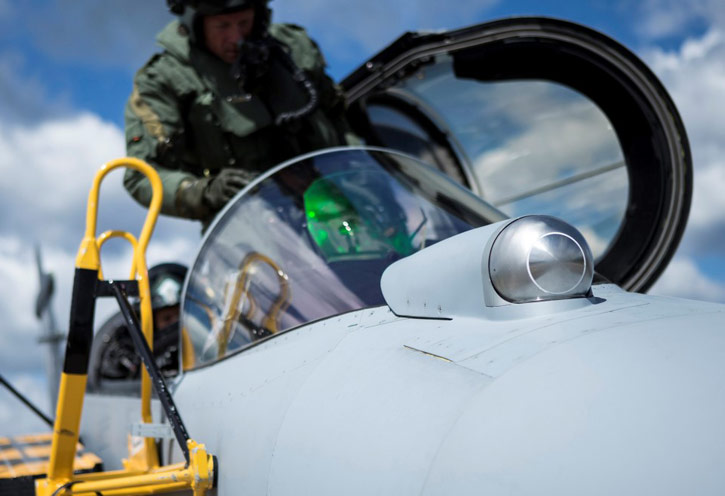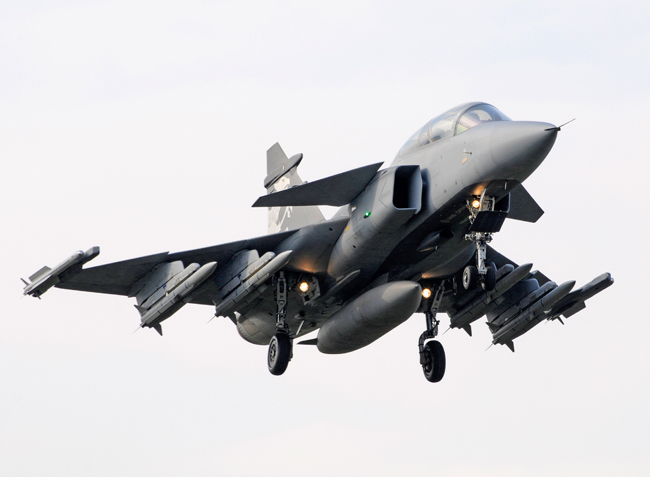Saab rolled out the newest member of the Gripen family of fighter jets – the Gripen E. Saab defines the new fighter as ‘revolutionary’ because it combines advanced technology and operational effectiveness in an affordable package that no other fighter aircraft can. Defense-Update takes a look at what the new fighter jet can do.
Based on the proven Gripen C/D platform, the Gripen E (also referred to as Gripen E/F) is designed as a multi-role fighter designed to perform air/air, air/ground and aerial recce with the same aircraft on a single mission. Compared with previous Gripen models (C/D) the new version has increased range and mission endurance. Its redesigned airframe operates at higher weights and is configured for maximum takeoff weight of 16.5 tons, allowing Gripen E to carry more fuel and weapons. The aircraft has 10 hardpoints and carries additional pylons to increase weapon capacity.
The integration of a powerful (98 kN) and efficient GE F414G engine provides a higher level of thrust. Digital fly-by-wire and canards are providing the high aircraft agility while the excess power delivered by the new engine sustains high speed (Mach 2) and super-cruising capability, a unique feature for a fighter jet of this size.
Saab is developing the single-seat version of the aircraft – Gripen E – for the Swedish Air Force and the Brazilian Air Force. Brazil’s Embraer is responsible for the development of a two-seater variant (Gripen F). The Brazilian Air Force plans to operate six such aircraft.
Since the Gripen A/B and C/D fighters currently fly with several NATO air forces, Gripen E is also designed to be NATO-interoperable and is tailored for the future Network Centric Warfare (NCW) environment. Such capabilities comprise advanced data communications, dual data links, satellite communications and video links. A formation of Gripen E will be able can share tactical and logistical information including the position, fuel and weapon status of each aircraft. Besides, the pilot can communicate two ways with every networked element, in the air, on the ground or at sea through the secure and multi-frequency data links, using line-of-sight or satellite links.
Advanced sensors available on board add new capabilities to air/air and air/ground warfighting capability, these include the Leonardo Selex ES-05 Raven Active Electronic Scan Array (AESA) Radar and Infrared Search and Track (IRST) adding passive tracking and target acquisition capability to the Gripen’s tactics portfolio. The antenna uses a swash-plate solution that gives the radar an area coverage of ± 100°.

The Skyward IRST (also built by Selex) can operate in synch with the radar, to provide visual target identification from a long distance, or function as ’passive radar’, enabling Gripen E pilots to track and engage targets without giving away their positions. The sensor is looking forward over a wide sector, registering heat emissions from other aircraft, helicopters, objects on the ground and sea surface.
The third sensor on board is the electronic countermeasures system, that can operate with active (Missile Approach Warning – MAW) and passive (Radar Warning Receiver – RWR) sensors, detecting hostile radar emissions that ‘paint’ the Gripen from a distance, or missiles closing in from afar, guided by radar signals. The EW system couples with active countermeasures, including chaff, flares and expendable decoys such as the BriteCloud, as well as RF jammer pod and anti-radiation missiles that could be integrated in the future, to defeat such threats.
These sensors are combined with cockpit instrumentation to provide the pilot with situational picture, using comprehensive display systems that include Helmet Mounted Display (which also combines night vision), Head-Up Display (HUD) and Wide Area Displays (WAD) to be integrated into the Gripen NGs destined for the Brazilian Air Force. This combination of displays delivers the ability to detect and destroy a wide variety of targets, even at night or in poor weather conditions.



















